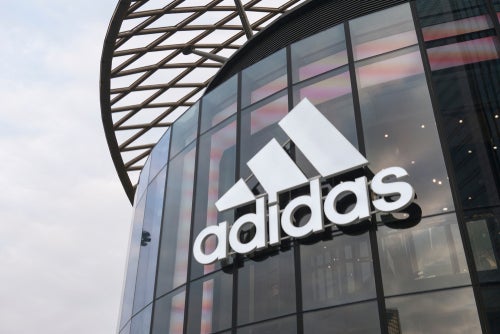
For the 12 months ended 31 December 2022, Adidas saw earnings slide 83% to EUR254m (US$268m), partly a result of one-off costs amounting to EUR350m related to the wind-down of its Russia business, a legal dispute, inflation and restructuring.
Gross margin narrowed to 47.3% from 50.7% a year earlier. Adidas blamed a strong increase in supply chain costs reflecting increased product costs and freight expenses. In addition, higher discounts, particularly in the second half of the year, a less favourable market, category, and channel mix as well as negative currency developments weighed on the result.
Sales, meanwhile, were down 6% to EUR22.5bn, impacted by the termination of Adidas’ partnership with Yeezy. On a currency-neutral basis, sales were up 1% reflecting growth in all markets except Greater China. The sportwear retailer saw growth in both wholesale (+1%) and the company’s own direct-to-consumer (DTC) business (+2%).
From a market perspective, currency-neutral sales grew at a double-digit rate in Latin America (+44%) and North America (+12%). Revenues in EMEA were up 9%, and sales in Asia-Pacific grew 4% in 2022. In Greater China, however, revenues declined 36% due to the “challenging market environment, company-specific challenges as well as significant inventory takebacks”.
For the current financial year, Adidas is expecting currency-neutral revenues to decline at a high-single-digit rate, and reported operating loss to be EUR700m.
“2023 will be a transition year to build the base for 2024 and 2025,” said Bjørn Gulden, CEO of Adidas. “We need to reduce inventories and lower discounts. We can then start to build a profitable business again in 2024. Adidas has all the ingredients to be successful. But we need to put our focus back on our core: product, consumers, retail partners, and athletes. We will work on strengthening our people and the adidas culture.”

US Tariffs are shifting - will you react or anticipate?
Don’t let policy changes catch you off guard. Stay proactive with real-time data and expert analysis.
By GlobalDataIn a separate announcement, Adidas confirmed it had extended the appointment of Harm Ohlmeyer as chief financial officer by another three years until the beginning of 2028. Ohlmeyer has been member of the executive board since March 2017 and the company’s CFO since May 2017.
Adidas needs to act quick to fix the fallout from Yeezy
Chloe Collins, head of apparel at GlobalData, believes Adidas’ success with sponsorship last year wasn’t enough to offset the negative impact of the Yeezy controversy on the brand.
“Adidas has once again produced disappointing results, with FY2022 sales only increasing 6.0% to EUR22.5bn, remaining 4.8% behind pre-pandemic FY2019 levels despite the global sportswear market growing 9.6% during the three years.
“Currency-neutral sales only rose 1%, and operating profit plunged 66.3% as a result of increased costs, more discounting and its exit from Russia. In Q4, despite Adidas’ sponsorship of winning team Argentina, the presence of the FIFA Men’s World Cup was not enough to offset the negative impact of the Yeezy controversy on the brand or the fact that its designs lag behind rivals Nike and Puma, with Q4 FY2022 sales growth muted at 1.3% despite being up a weak comparative period plagued by Omicron. New CEO Bjørn Gulden’s first year with the brand is set to be a huge challenge, as alongside weak consumer confidence, it could lose up to EUR1.2bn in sales and EUR500m in operating profit if it fails to sell its remaining Yeezy inventory, resulting in a high single digit revenue decline in FY2023.
“A catastrophic performance in China was partially to blame for Adidas’ performance in FY2022, as further lockdowns and a shift to local sportswear brands like Li-Ning and ANTA caused currency-neutral sales to topple 35.8%. Latin America saw the strongest growth of 43.7%, followed by North America and Europe at 11.9% and 8.8% respectively. Though restrictions in China are hopefully off the radar for FY2023, Adidas will continue to struggle in the region until it increases appeal with local consumers, and performance in Europe is likely to get much worse as many shoppers will be forced to limit spend amid high inflation. Sportswear shoppers will become even more brand loyal, and Adidas must work harder to compete against top dog Nike. The launch of its new label, Adidas Sportswear, should help. Fronted by actress Jenna Ortega, the more fashionable range made from performance materials should allow the brand to capture more Gen Z shoppers and take advantage of the long-term casualization within the apparel market, though it is unlikely to be enough to make up for the fallout from Yeezy.
“Adidas is still deciding what to do with its remaining Yeezy inventory, despite reaching an agreement with West allowing the brand to sell it. It faces a difficult choice, as selling the stock could damage its brand perception even further, and not selling it will have a disastrous effect on profit. If the brand does choose to sell it, the stock will likely clear as though more muted than before, Yeezy continues to experience high demand on resale sites like Stock X, proving that some of its loyal customers care more about supply running out than the controversy surrounding West. However, it should ensure any stock relist is done with minimal fanfare to avoid a PR nightmare.”



